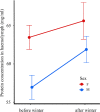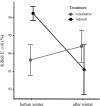Changes in haemolymph parameters and insect ability to respond to immune challenge during overwintering
- PMID: 33976809
- PMCID: PMC8093749
- DOI: 10.1002/ece3.7323
Changes in haemolymph parameters and insect ability to respond to immune challenge during overwintering
Abstract
Overwintering is a challenging period in the life of temperate insects. A limited energy budget characteristic of this period can result in reduced investment in immune system. Here, we investigated selected physiological and immunological parameters in laboratory-reared and field-collected harlequin ladybirds (Harmonia axyridis). For laboratory-reared beetles, we focused on the effects of winter temperature regime (cold, average, or warm winter) on total haemocyte concentration aiming to investigate potential effects of ongoing climate change on immune system in overwintering insects. We recorded strong reduction in haemocyte concentration during winter; however, there were only limited effects of winter temperature regime on changes in haemocyte concentration in the course of overwintering. For field-collected beetles, we measured additional parameters, specifically: total protein concentration, antimicrobial activity against Escherichia coli, and haemocyte concentration before and after overwintering. The field experiment did not investigate effects of winter temperature, but focused on changes in inducibility of insect immune system during overwintering, that is, measured parameters were compared between naïve beetles and those challenged by Escherichia coli. Haemocyte concentration decreased during overwintering, but only in individuals challenged by Escherichia coli. Prior to overwintering, the challenged beetles had a significantly higher haemocyte concentration compared to naïve beetles, whereas no difference was observed after overwintering. A similar pattern was observed also for antimicrobial activity against Escherichia coli as challenged beetles outperformed naïve beetles before overwintering, but not after winter. In both sexes, total protein concentration increased in the course of overwintering, but females had a significantly higher total protein concentration in their hemolymph compared to males. In general, our results revealed that insect's ability to respond to an immune challenge is significantly reduced in the course of overwintering.
Keywords: Climate change; antimicrobial response; bacterial challenge; cold tolerance; fluctuating temperatures; haemocytes; innate immunity; invasive species; trade‐off.
© 2021 The Authors. Ecology and Evolution published by John Wiley & Sons Ltd.
Conflict of interest statement
Authors declare no conflict of interest.
Figures




Similar articles
-
Fungal ectoparasites increase winter mortality of ladybird hosts despite limited effects on their immune system.Proc Biol Sci. 2022 Mar 30;289(1971):20212538. doi: 10.1098/rspb.2021.2538. Epub 2022 Mar 23. Proc Biol Sci. 2022. PMID: 35317669 Free PMC article.
-
Effects of the winter temperature regime on survival, body mass loss and post-winter starvation resistance in laboratory-reared and field-collected ladybirds.Sci Rep. 2020 Mar 18;10(1):4970. doi: 10.1038/s41598-020-61820-7. Sci Rep. 2020. PMID: 32188924 Free PMC article.
-
Impact of cold on the immune system of burying beetle, Nicrophorus vespilloides (Coleoptera: Silphidae).Insect Sci. 2017 Jun;24(3):443-454. doi: 10.1111/1744-7917.12321. Epub 2016 May 25. Insect Sci. 2017. PMID: 26799536
-
Insect overwintering in a changing climate.J Exp Biol. 2010 Mar 15;213(6):980-94. doi: 10.1242/jeb.037911. J Exp Biol. 2010. PMID: 20190123 Review.
-
Linking energetics and overwintering in temperate insects.J Therm Biol. 2015 Dec;54:5-11. doi: 10.1016/j.jtherbio.2014.07.007. Epub 2014 Jul 24. J Therm Biol. 2015. PMID: 26615721 Review.
Cited by
-
Fungal ectoparasites increase winter mortality of ladybird hosts despite limited effects on their immune system.Proc Biol Sci. 2022 Mar 30;289(1971):20212538. doi: 10.1098/rspb.2021.2538. Epub 2022 Mar 23. Proc Biol Sci. 2022. PMID: 35317669 Free PMC article.
-
Increased pupal temperature has reversible effects on thermal performance and irreversible effects on immune system and fecundity in adult ladybirds.Commun Biol. 2023 Aug 12;6(1):838. doi: 10.1038/s42003-023-05196-0. Commun Biol. 2023. PMID: 37573399 Free PMC article.
-
The Influence of Daily Temperature Fluctuation on the Efficacy of Bioinsecticides on Spotted Wing Drosophila Larvae.Insects. 2022 Dec 31;14(1):43. doi: 10.3390/insects14010043. Insects. 2022. PMID: 36661971 Free PMC article.
References
-
- Adamo, S. A. , Davies, G. , Easy, R. , Kovalko, I. , & Turnbull, K. F. (2016). Reconfiguration of the immune system network during food limitation in the caterpillar Manduca sexta. Journal of Experimental Biology, 219, 706–718. - PubMed
-
- Bale, J. S. , & Hayward, S. A. L. (2010). Insect overwintering in a changing climate. Journal of Experimental Biology, 213, 980–994. - PubMed
-
- Berkvens, N. , Bale, J. S. , Berkvens, D. , Tirry, L. , & De Clercq, P. (2010). Cold tolerance of the harlequin ladybirdHarmonia axyridisin Europe. Journal of Insect Physiology, 56, 438–444. - PubMed
-
- Brown, P. M. J. , Thomas, C. E. , Lombaert, E. , Jeffries, D. L. , Estoup, A. , & Lawson Handley, L.‐J. (2011). The global spread of Harmonia axyridis (Coleoptera: Coccinellidae): Distribution, dispersal and routes of invasion. BioControl, 56, 623–641.
-
- Chen, C. P. , & Denlinger, D. l. (1987). A rapid cold‐hardening process in insects. Science, 238, 1415–1417. - PubMed
LinkOut - more resources
Full Text Sources
Other Literature Sources
Molecular Biology Databases

